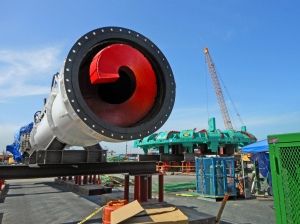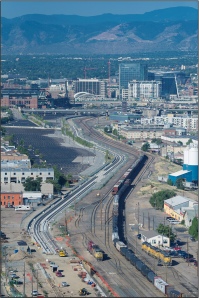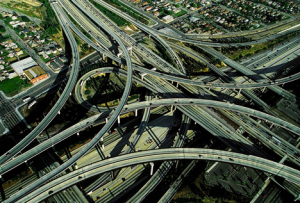We’ve spent the last two months talking about some of the world’s biggest and most fascinating construction projects. Our series on Big Projects proved to be a world-wide endeavor, taking us from Japan to San Francisco, Denver to Seattle, and many points in between. We hope you enjoyed the travel and stories as much as we did!

Bertha – The world’s largest diameter tunneling machine
(Credit: Washington State Department of Transportation)
If there was one common thread, it was that communications and public involvement were critical components of all of these projects. Regardless of size, budget or locale, there is no substitute for keeping stakeholders informed and engaged. That’s because Big Projects are sometimes born from big natural disasters that impact big portions of our population.
Earthquakes, for example, sparked two of our Big Projects, the Alaskan Way Viaduct in Seattle and the San Francisco-Oakland Bay Bridge.
In Seattle, we introduced you to Bertha, the world’s largest-diameter tunneling machine, which is hard at work beneath downtown Seattle making way for a new underground portion of the Alaskan Way Viaduct, a double-deck highway running through Seattle’s core, which was damaged in that city’s devastating 2001 earthquake. This project proved to be one of the most scrutinized public participation processes in the state’s history, including more than 90 alternative options for the viaduct’s replacement.
We also showed you the breadth and beauty of the new East Span of the San Francisco-Oakland Bay Bridge, which opened to traffic recently after 11 years of continuous construction. The original bridge was damaged in the 1989 Loma Prieta earthquake. We learned shortly after this blog post ran that Guinness World Records officially named the bridge the widest in the world, with a total deck width of 258.33 feet. That width accommodates 10 lanes of vehicle traffic, a 15.5-foot-wide bike path, and a gap where the central tower supports the two bridge deck sections. Did we happen to mention that the bridge already held the title of world’s longest self-anchored suspension span with a length of 2,047 feet?

New track installation through Coors Field as part of the Denver FasTracks Program.
(Photo courtesy of HDR Inc., © 2013 by Keith Philpot)
Sometimes it’s not an earthquake that sparks these projects, but a tsunami (of sorts). That was the case with the FasTracks Program in Denver, where they’re expecting a tidal wave of population growth in the next 12 years. About a million more people are expected to move into (or be born into) the Denver region by 2025. To keep up with this kind of growth, officials hammered out a multi-billion dollar comprehensive transit expansion plan to be paid for by an increase in the local sales tax. The plan includes more than 100 miles of new rail projects, and also bus rapid transit, new parking spaces at transit stations and enhanced bus service.
We also had some fun this month looking at some Big Ideas – some that are almost complete and others that exist only on paper.
The century-old the Panama Canal has been aging gracefully, thanks in part to a nearly-completed massive renovation project which includes construction of two new locks with three chambers, each helping to double its current capacity. The Panama Canal Expansion Program also includes improvements to the artificial Gatun Lake and the Culebra Cut to make it safer and easier for big ships to navigate.
We showed you the amazing Hyperloop, the brain child of Tesla Motors CEO Elon Musk. This engineering marvel will reportedly whisk commuters from Los Angeles to San Francisco in about 30 minutes, at speeds of up to 760 miles per hour. Then there was the vertigo-inducing Sky City 1000 project, a mixed-use super-highrise planned for Tokyo that could go as high as 328 stories.
We finished out the month much closer to home with a fascinating Q&A with San Diego City Councilman Mark Kersey, who chairs the City’s Infrastructure Committee.
Why infrastructure, you ask? Well, most Big Projects ARE infrastructure, which is a key component of our way of life. Crumbling infrastructure has become a virtual epidemic across the country, and San Diego is the poster child for this civic disease with a more than $1 billion backlog of infrastructure needs.
Kersey’s newly created committee oversees the City’s Capital Improvements Program (CIP) and endeavors to prioritize CIP projects. Despite this huge job, Kersey was gracious enough to take time out of his busy schedule to answer our questions.
As we do every month, we now pause to recognize the contributors who made the past two months’ of blog posts possible.
We’d like to thank:
- KaDeena Yerkan, the Manager of Communications and Public Involvement for the Washington State Department of Transportation’s Alaskan Way Viaduct Replacement Program.
- Andrew Gordon, San Francisco-Oakland Bay Bridge spokesperson.
- Pauletta Tonilas, Denver FasTracks Public Information Manager.
- San Diego City Councilman Mark Kersey.
Stay with us next month as we continue our BIG concept, shifting focus to projects large and small that have a big impact as we explore renewable energy. After all, one of the biggest challenges we face is creating a sustainable future for the planet. We will focus on projects, collaborative efforts, and big ideas that are leading the charge.
Jonathan Heller, Senior Writer
Collaborative Services, Inc.



Recent Comments